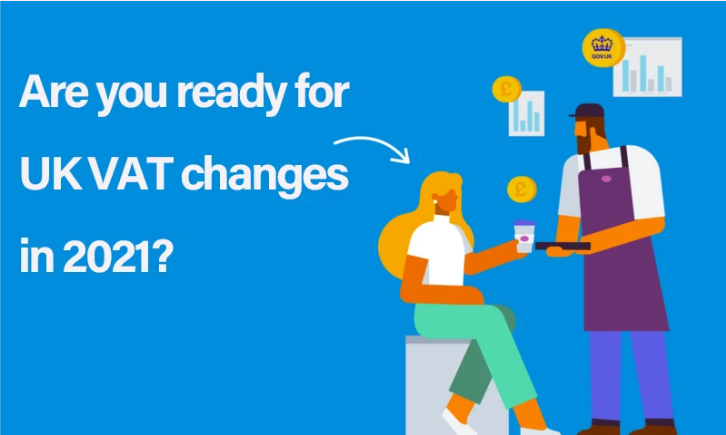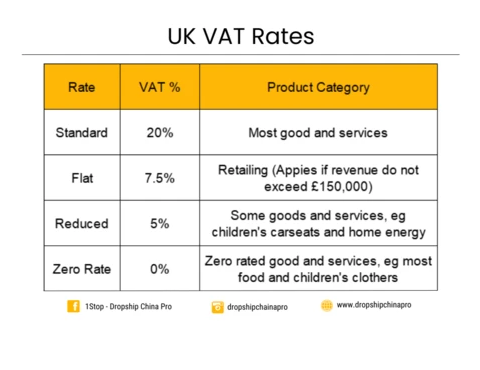
If you are an E-commerce entrepreneur and you sell your products in the UK through online market places like Amazon and eBay or dropshipping platforms like Shopify, Wish, and Wocommerce, you probably are concerned about the new changes in the UK VAT policy that will come into effect on January 1st, 2021 and the implications that these changes represent for your dropshipping business.
You must be asking yourself questions like What are the new VAT changes for E-commerce and dropshipping in the UK? What do these changes represent for my e-commerce business? What should I do to keep my dropshipping business alive despite these new changes? How to register for VAT?
Today we are going to answer all these questions by identifying these changes, pointing out their advantages and disadvantages, and guiding you on when and how UK-based and overseas companies should register for VAT declaration.
What is going to change after January 1st?
1. £15 Low-Value Consignment Relief (LVCR) will be removed.
The LCVR currently means that goods valued at £15 or less are not subject to UK import VAT. Removing the LVCR means that for goods sold at £135 or less, sellers or their postal service will have to declare and pay VAT to HMRC directly.
2. Dropshipping VAT is due at Point of Sale (POS) rather than Import VAT:
This means that if you sell your products through online shops from Shopify, Wish, Wocommerce, etc., and fulfill your orders from outside the UK, (using Oberlo, Aliexpress, or other Chinese fulfillment centers) into the UK, VAT will be due at the Point of Sale (POS) rather than at the moment of import into the UK, the POS will be your store payment gateway (Stripe, Shopify Payments, PayPal, etc.) this means you will need to start collecting VAT right when you make sales through your online store.
Since you need to account for VAT at POS and you cannot add VAT at checkout, you will need to include the VAT within your listed selling price, register and account for the VAT to HMRC.

3. VAT accounting and collection made by Online Marketplaces
If you sell goods via an OMP, such as Amazon, Etsy, or eBay, and your goods are being imported into the UK straight to consumers, then, the OMP facilitating the sale will be responsible for collecting and charging VAT. This will be applied to the consumer at the time of the sale via the checkout by the marketplace. You as the seller will instead make a zero-rated supply to the marketplace, including this amount as zero-rated on your UK VAT return.
This measure will apply to goods of any value where the:
- Goods are owned by a seller who is based outside the UK
- Goods are located in the UK at the point of sale
- Seller sells the goods to a customer in the UK through an online marketplace
- Supply is not to a VAT registered business.
Important note: If you sell from the UK to the UK nothing changes and existing rules still apply.
What are the advantages and disadvantages of such changes?
Now that you know what are the changes to be implemented next year, let’s identify what are the positive and negative impacts of such changes on your dropshipping business. We will point out the disadvantages first and the advantages in the second place. But do not worry, there is more good news than bad news.
Disadvantages:
- Slow deliveries: if you thought delivery times slowed significantly during the early months of COVID-19, get ready for Brexit. Experts predict that supply chains will struggle during the adjustment period, as sellers, shipping companies, and border agents adjust to new checks, protocols, and customs clearances.
- Products will look more expensive: Charging VAT can make your goods and services more expensive, particularly if your customers or clients are not VAT-registered business, or are end consumers who are not able to reclaim VAT.
- Higher prices: To maintain the profit margins you need to increase your prices by 20%, which will be hard for British consumers to accept at the beginning of this transitions most people cannot increase their prices by 20% without negatively affecting their conversion rate, so you might need to absorb the cost while consumers get used to the prices increase.
- Administrative burden: As a VAT-registered business, there are VAT rules and record-keeping requirements you’ll need to comply with. Some of these rules can be complicated, and you may be liable for a penalty if you make a mistake.
Advantages:
- It enhances a better perception of your business. Registering for VAT tends to lend credibility to your business, and makes your company appear larger and more established. This can enhance your market appeal to other businesses and customers.
- If you are registered at UK VAT, you can reclaim VAT on goods and services you’ve purchased from other businesses based in the UK, and this can be advantageous in certain situations.
- The basis for VAT calculation will only be the value of the goods (not including the postage) and that additional collection or handling fees would disappear.
- If your customers or clients are VAT-registered businesses or persons they can reclaim the VAT paid for your products.
- You are not the only one who is going to be charged with VAT, every dropshipper or online store owner will be charged as well, meaning that the overall prices of goods sold online in the UK will raise in 2021, it will take a while for British consumers to accept this changes but it will get better, this is only a transition, it does not mean that dropshipping or E-commerce businesses will die in the UK.
- Dropshipping businesses importing or selling goods to the UK will no longer be required to pay VAT upfront when goods arrive.
- Goods which value is under £135 and are sold on OMP like Amazon, eBay or through online stores in Shopify, Wocommerce, Wish, etc., will be temporarily exempt from import duties when imported, and sellers can have more choices in the products.
- Given the current global conditions and the complexity of this new policy, these changes are more likely to be implemented later than they are officially meant to, so you still have time to prepare everything you need to be ready for these changes.
- There are certain shipping companies that do not ask sellers (dropshippers) to provide VAT numbers to deliver dropshipping parcels to the UK so it seems that registering for VAT is not a requirement for being able to ship your products.
What actions to take next year?
- Adjust your tax settings in Shopify.
- Review your SKUs and calculate the impact VAT is going to have on your margin for each product.
- Increase prices and/or kill unprofitable products
- Register for VAT -(effective date 1 Jan 2021). If you are currently selling to the UK you should start looking for advice from a UK-based accountant, lawyers, or other specialists.
- Overseas sellers need to register for VAT as soon as they start selling to the UK.
- UK-based companies need to register for VAT if the expected turnover or turnover for the last 12 months is over £85,000.
- Account for the UK VAT due to HMRC on all of its sales file for and remit VAT to HM Revenue and Customs (HMRC) every quarter.
- Apply for VAT flate rate (7.5%) if neither you expected or past revenue are less than £150.000
Please do not bury your head in the sand – the cost of non-compliance penalties can be worse if you get caught avoiding VAT.
When to register for VAT?
UK-Based Companies:
If your company is registered in the UK, you must register for VAT if:
– You expect your VAT taxable turnover to be more than £85,000 in the next 30-day period
– Your business had a VAT taxable turnover of more than £85,000 over the last 12 months
You might also need to register in some other cases, depending on the kinds of goods or services you sell and where you sell them.
You can apply for a registration ‘exception’ if your taxable turnover goes over the threshold temporarily and your company is registered in the UK.
Overseas companies:
If your business is outside the UK (you are a seller from other country rather than the UK):
There is no threshold if neither you nor your business is based in the UK, this means you must register as soon as you supply any goods and services to the UK (or if you expect to in the next 30 days).
Late registration
If you register late, you must pay what you owe from when you should have registered.
You may get a penalty depending on how much you owe and how late your registration is.
How to register for VAT?
1. Online: Most businesses (including partnerships and a group of companies registering under one VAT number) can register online and create a VAT online account.
2. Using an agent: You can appoint an accountant (or agent) to submit your VAT Returns and deal with HMRC on your behalf, this option is super convenient for Dropshippers who have companies registered in countries out of the UK.
When you receive your VAT number from HMRC, you can sign up for a VAT online account (select option ‘VAT submit returns’).
What if you cannot register online?
You must register by post using VAT1 if:
- You want to apply for a ‘registration exception’
- You’re joining the Agricultural Flat Rate Scheme
- You’re registering the divisions or business units of a body corporate under separate VAT numbers
Register by post using the form:
- VAT1A if you’re an EU business ‘distance selling’ to the UK
- VAT1B if you import (‘acquire’) goods worth more than £85,000 from an EU country
- VAT1C if you’re disposing of assets on which 8th or 13th Directive refunds have been claimed
When you receive your VAT number from HMRC, you can sign up for a VAT online account (select option ‘VAT submit returns’).
Importante notice: As dropshipping is a way of reatailing you can apply for VAT flate rate (7.5%)if neither you expected or past revenue are less than £150.000
Getting your certificate:
You should get a VAT registration certificate within 30 working days, though it can take longer. This certificate will be sent either to your VAT online account or by post – if an agent registers you or you cannot register online.
What you need to know
- You need to provide details like your turnover, business activity, and bank details.
- Your registration date is known as your ‘effective date of registration’. You’ll have to pay HMRC any VAT due from this date.
- You do not need to authorize an agent to register you for VAT.
What do I need to do after I’ve registered for VAT?
Once you’ve registered for VAT, you’ll need to:
1. Abide by HMRC’s record-keeping requirements
As a VAT-registered businesses, you are required to keep records of:
- Copies of all invoices issued and received.
- Self-billing agreements as well as name, address, and vat number of self-billing suppliers
- Debit or credit notes and. import and export records
- Records of items you can’t reclaim vat on and goods you give away or take from stock for private use
- A separate record of the vat you charge and the vat you pay on your purchases. This is known as the vat account.
- General business records, such as bank statements and receipts
With the roll-out of Making Tax Digital in April 2019, you still have the same record-keeping requirements – except that now you have to keep a digital record of the following:
- Your business name, address, and vat registration number
- Any vat accounting schemes you use
- The ‘time of supply’ and ‘value of supply’ (value excluding vat) for everything that you purchase and sell
- The vat on everything you purchase and sell
- You need to keep records for a minimum of six years.
- If you’re using the VAT MOSS service, you need to keep records for 10 years.
2. Issue VAT invoices
Depending on the type of VAT invoice you are issuing, you need to include the following:
- Requirements by type of VAT Invoice
- Requirements by type of VAT Invoice
- If items are charged at different VAT rates, you’ll need to indicate the rates for each item.
3. Submit your VAT return
You will need to submit your VAT return online every quarter, even if you don’t have VAT to pay or reclaim.
How often you need to submit your VAT return may vary depending on the VAT scheme you choose, and we’ll dive into this in further detail in the next section.
The deadline for submitting a VAT return and making payments is a month and seven days after the end of a VAT period.
Contact our dropshipping experts for further consultation.





